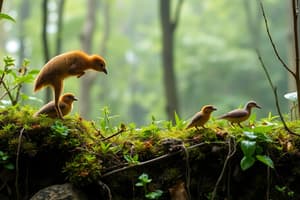Podcast
Questions and Answers
What defines a community in ecological terms?
What defines a community in ecological terms?
A community is defined as an assemblage of populations of various species living close enough for potential interaction.
Explain the concept of competitive exclusion.
Explain the concept of competitive exclusion.
Competitive exclusion is the local elimination of a competing species when two species compete for the same limiting resource.
What is the difference between a fundamental niche and a realized niche?
What is the difference between a fundamental niche and a realized niche?
The fundamental niche is the potential environment where a species can survive without competition, while the realized niche is the actual niche occupied influenced by community interactions.
What is resource partitioning and why is it significant?
What is resource partitioning and why is it significant?
How does character displacement occur in sympatric populations?
How does character displacement occur in sympatric populations?
What defines predation in ecological interactions?
What defines predation in ecological interactions?
How does camouflage benefit prey species?
How does camouflage benefit prey species?
What is the difference between Batesian and Mullerian mimicry?
What is the difference between Batesian and Mullerian mimicry?
What is mutualism and provide an example?
What is mutualism and provide an example?
Define the term 'commensalism' in ecological interactions.
Define the term 'commensalism' in ecological interactions.
What role does herbivory play in ecological communities?
What role does herbivory play in ecological communities?
What are the two components of species diversity?
What are the two components of species diversity?
Explain the concept of facilitation in ecology.
Explain the concept of facilitation in ecology.
Flashcards
Community
Community
A group of different species living close to each other where they can interact.
Interspecific Interactions
Interspecific Interactions
Relationships between different species in a community.
Competition
Competition
When different species fight for the same limited resources.
Competitive Exclusion
Competitive Exclusion
Signup and view all the flashcards
Ecological Niche
Ecological Niche
Signup and view all the flashcards
Fundamental Niche
Fundamental Niche
Signup and view all the flashcards
Realized Niche
Realized Niche
Signup and view all the flashcards
Resource Partitioning
Resource Partitioning
Signup and view all the flashcards
Character Displacement
Character Displacement
Signup and view all the flashcards
Predation
Predation
Signup and view all the flashcards
Camouflage
Camouflage
Signup and view all the flashcards
Cryptic Coloration
Cryptic Coloration
Signup and view all the flashcards
Aposematic Coloration
Aposematic Coloration
Signup and view all the flashcards
Batesian Mimicry
Batesian Mimicry
Signup and view all the flashcards
Mullerian Mimicry
Mullerian Mimicry
Signup and view all the flashcards
Herbivory
Herbivory
Signup and view all the flashcards
Symbiosis
Symbiosis
Signup and view all the flashcards
Parasitism
Parasitism
Signup and view all the flashcards
Mutualism
Mutualism
Signup and view all the flashcards
Commensalism
Commensalism
Signup and view all the flashcards
Facilitation
Facilitation
Signup and view all the flashcards
Species Richness
Species Richness
Signup and view all the flashcards
Relative Abundance
Relative Abundance
Signup and view all the flashcards
Shannon Diversity Index
Shannon Diversity Index
Signup and view all the flashcards
Trophic Structure
Trophic Structure
Signup and view all the flashcards
Study Notes
Community Ecology
- Community: An assemblage of populations of various species living close enough for potential interaction. Affected by environmental conditions, including invasive species.
Interspecific Interactions
-
Interspecific Interactions: Relationships between species in a community. Examples include: competition, predation, herbivory, and symbiosis. Categorized by their effect on the involved species (e.g., positive, negative, or neutral).
-
Competition: (Negative/Negative) Occurs when two+ species compete for a limited resource. Potentially leads to competitive exclusion (local elimination of a competing species) – a concept proposed by Georgy Gause.
Ecological Niche
-
Ecological Niche: An organism's ecological role or function.
-
Fundamental Niche: The potential niche a species could occupy without competition.
-
Realized Niche: The actual niche a species occupies due to interactions with other species. Realized niche is influenced by community interactions.
Resource Partitioning
- Resource Partitioning: Differentiation of ecological niches, allowing similar species to coexist. Example: Anolis lizard species differentiate their perching locations (sun vs. shade). Acomys rusatus and Mus spretus exhibit temporal partitioning by active times of day.
Character Displacement
- Character Displacement: Sympatric populations of species exhibit more divergent characteristics than allopatric populations of the same species. Example: beak size variation in Galapagos finches.
Predation
-
Predation: (Positive/Negative) One species (predator) kills and eats another (prey).
-
Camouflage/Cryptic Coloration: Prey adaptation where they blend into their environment, avoiding predators. Example: Canyon tree frogs.
-
Aposematic Coloration: Warning coloration in prey to signal danger. Example: Poison dart frogs.
-
Batesian Mimicry: A harmless species mimics a harmful one. Example: Hawkmoth larva mimicking a snake.
-
Mullerian Mimicry: Two unpalatable (harmful) species mimic each other.
Herbivory
- Herbivory: (Positive/Negative) Interaction where an herbivore consumes plant or algal parts. Influences plant diversity and species composition.
Symbiosis
-
Symbiosis: Close, long-term relationships between two+ species.
- Parasitism: (Positive/Negative) One organism (parasite) benefits at the expense of another (host).
-
Endoparasites: Live inside the host.
-
Ectoparasites: Live on the host's surface.
- Mutualism: (Positive/Positive) Win-win relationship benefiting both species.
-
Obligate Mutualism: One species cannot survive without the other (e.g., ants and acacia trees).
-
Facultative Mutualism: Both species can survive independently but benefit from the interaction (e.g., bees and flowering plants)
- Commensalism: (Positive/Neutral) One species benefits, the other is unaffected. Difficult to prove in nature. (e.g., barnacles and whales)
Facilitation
- Facilitation: One species positively affects another without direct contact.
Species Diversity
-
Species Diversity: Variety of organisms in a community.
-
Species Richness: Total number of different species.
-
Relative Abundance: Proportion of each species in the community.
-
-
Shannon Diversity Index: An index to compare species diversity in communities. High diversity relates to higher community productivity, greater stability, and greater resistance to environmental stressors/invasive species.
Trophic Structure
Studying That Suits You
Use AI to generate personalized quizzes and flashcards to suit your learning preferences.




